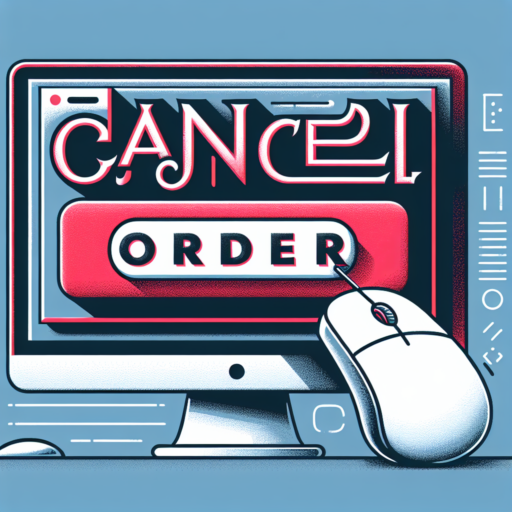How to Cancel an Order: A Step-by-Step Guide
Canceling an online order can sometimes feel like navigating through a maze, especially if you are doing it for the first time. However, with the right steps, you can ensure that the process is smooth and hassle-free. Whether you’ve had a change of heart or simply made a mistake, it’s important to act swiftly to avoid complications. This guide will walk you through the essential steps on how to cancel an order, making the process straightforward and manageable.
Step 1: Check the Cancellation Policy
Before you take any action, it’s crucial to review the seller’s cancellation policy. Most online retailers and service providers have a specific timeframe during which you can cancel an order without incurring additional fees. Finding this information usually requires visiting the seller’s website and navigating to their FAQ or Help section. Understanding the cancellation policy will give you a clearer picture of your options and any potential costs involved.
Step 2: Cancel the Order through Your Account
For most online platforms, the simplest way to cancel an order is directly through your user account. Log in and navigate to your order history, where you should find a list of your recent purchases. Locate the order you wish to cancel and look for a “Cancel Order” or similar button. This button will typically initiate the cancellation process, prompting you to confirm your decision. Some websites may ask you to provide a reason for the cancellation, although this is usually optional.
It’s worth noting that if you encounter any issues during this process or if the cancellation option is not available, reaching out to customer service directly is your next best step. Most companies are more than willing to assist with order cancellations, especially if contacted promptly. Remember, the key to a smooth cancellation is acting quickly and following the retailer’s guidelines.
Understanding Your Rights: The Cancellation Policy Every Shopper Should Know
When engaging in both online and offline shopping, the intricacies of cancellation policies can often seem daunting. However, a solid understanding of your rights can empower you to make informed decisions and, when necessary, take decisive action. The aim of this brief exploration is to shed light on the key aspects of cancellation policies that affect consumers.
First and foremost, it’s imperative to acknowledge that cancellation policies can vary widely between retailers. This divergence is not arbitrary but is instead tailored to accommodate the nature of the goods or services provided. Digital products, for instance, may have stricter cancellation policies due to the immediate access provided upon purchase.
Another vital component to understand is the legal framework that governs these policies. Many jurisdictions mandate a «cooling-off» period, typically around 14 days, during which consumers can cancel a contract or purchase without any penalty. Familiarizing yourself with the regulations in your area can significantly enhance your shopping experience.
Top Reasons Why Customers Cancel Orders and How to Avoid Them
Understanding the reasons behind order cancellations can greatly help businesses in reducing their occurrence. One of the primary reasons customers cancel orders is due to extended delivery times. In today’s fast-paced world, buyers expect quick and efficient delivery services. When an order takes too long to arrive, customers might lose interest or find the product elsewhere, leading to cancellation.
Transparency Issues and Miscommunication
Another significant factor leading to order cancellations is the lack of transparency or miscommunication between the seller and the buyer. Customers value honesty and clear information regarding their orders. This includes accurate descriptions, real-time inventory updates, and immediate notification of any delays or issues. Failing to provide this can result in frustration and distrust, prompting customers to retract their orders.
Complex Checkout Process and Hidden Fees
A complicated checkout process or the sudden appearance of hidden fees also contributes to order cancellations. Shoppers prefer a straightforward and transparent purchasing experience. When confronted with unexpected costs or a convoluted checkout, customers may feel deceived or overwhelmed, leading them to abandon their purchase. Ensuring a simple, clear, and honest checkout process can significantly reduce the incidence of these cancellations.
Cancel Order FAQ: Answers to Your Most Common Questions
When it comes to online shopping, the flexibility to cancel an order is a crucial aspect for many customers. Understanding this need, we have compiled a list of frequently asked questions to guide you through the process of order cancellation, ensuring that you have all the necessary information at your fingertips.
How Can I Cancel My Order?
To cancel your order, you typically have a window from the time of purchase to a few hours after, depending on the company’s policy. It’s important to act quickly. To cancel, visit the «My Orders» section on the website or app, select the order you wish to cancel, and click on the «Cancel Order» option. A confirmation will be sent to you via email or SMS, confirming the cancellation.
Will I receive a full refund?
Refunds are generally processed in the original mode of payment. If you cancel your order before it ships, you are usually eligible for a full refund. However, the refund policy may vary depending on whether the order has been shipped or if you purchased a non-refundable item. It’s always best to check the specific refund policy for the most accurate information.
Remember, while cancelling an order is often straightforward, being informed about the specifics of the process and timelines can help prevent any unnecessary hassle. Checking the FAQ or help section of the website can also offer more detailed guidance tailored to particular needs or scenarios.
How to Cancel an Online Order Before it Ships
Cancelling an online order before it ships is a time-sensitive task that requires quick action. As soon as you realize you need to cancel your order, it’s crucial to initiate the process immediately to avoid any complications. Here are the steps you should take to ensure a smooth cancellation.
Step 1: Check the Cancellation Policy
Firstly, review the retailer’s cancellation policy. Most online retailers have clear guidelines on how and when an order can be cancelled. Typically, there’s a narrow window of opportunity to cancel an order before it moves to the shipping process. This information is often found in the FAQ or customer service section of the website.
Step 2: Contact Customer Service Promptly
If the policy indicates that you can cancel the order, the next step is to contact customer service immediately. This can usually be done through various channels such as email, phone, or live chat. When reaching out, have your order number ready to expedite the process. Explain your situation clearly and request the cancellation.
Step 3: Follow Up
After contacting customer service, you should receive a confirmation of your cancellation request. If you don’t receive confirmation within a reasonable timeframe, follow up. Keep a record of all communications regarding the cancellation, as you may need them if the order accidentally ships and you need to request a return or refund.
Remember, the key to cancelling an online order before it ships is swift action and clear communication with the retailer. By following these steps, you can increase your chances of successfully cancelling an order before it’s too late.
What Happens After You Cancel an Order? The Process Explained
Canceling an online order can seem like pressing a simple ‘cancel’ button, but what happens afterward involves a series of steps that might not be immediately visible to the shopper. Understanding this process is essential for both consumer satisfaction and for businesses aiming to streamline their operations.
Initially, once an order cancellation request is submitted, the system checks the status of the order. If the product has not been shipped, the cancellation process moves forward smoothly. However, if the product is already out for delivery or in transit, the cancellation becomes more complex. Retailers and logistics companies must then communicate to halt the delivery, a task that can involve multiple stakeholders across the supply chain.
The financial aspect of cancellation is also noteworthy. Upon a successful cancellation, the refund process begins. This entails verifying the transaction details and then initiating a refund to the customer’s payment method. The timeline for the refund to reflect in the customer’s account can vary significantly depending on the payment processor and the retailer’s policies. Consumers are advised to check with retailers about their specific refund time frames.
Dealing with Non-Refundable Orders: Tips and Strategies for Shoppers
Navigating the tricky waters of non-refundable orders can seem daunting at first. However, armed with the right knowledge and strategies, shoppers can effectively manage these situations and even turn them to their advantage. It’s essential to approach non-refundable orders with a clear strategy, understanding your rights as a consumer and the nuances of various sellers’ policies.
Understand the Seller’s Return Policy Thoroughly
Before making any purchase, especially one that is non-refundable, it’s imperative to fully understand the seller’s return policy. Policies vary widely between different retailers and understanding the specifics can save a ton of headaches down the road. Look for any loopholes or conditions under which a return might be accepted, even for non-refundable items. This may include receiving a defective product or an item that was not as described.
Communicate Directly and Politely with Sellers
If you find yourself in a situation where you need to contest a non-refundable order, direct communication with the seller is key. Crafting a polite and concise message explaining your situation can sometimes lead to a favorable resolution. Emphasize any discrepancies in your order or how the product failed to meet the advertised standards. Sellers are often willing to rectify issues to maintain customer satisfaction and avoid negative reviews.
In conclusion, while dealing with non-refundable orders can initially seem challenging, effective strategies such as understanding return policies and maintaining open communication can significantly mitigate potential losses. Shoppers equipped with these tips can navigate non-refundable purchases more confidently and efficiently.
How to Properly Communicate an Order Cancellation to Customer Service
Communicating an order cancellation to customer service should be handled with precision and politeness to ensure a smooth process. The initial step involves clearly stating your intention to cancel. Begin by providing your order details succinctly; this includes your order number, the date of the order, and any relevant personal identification information that might help the customer service agent locate your order quickly.
Utilizing a medium that provides a written record of your interaction is crucial. Email or the customer service platform’s messaging system are ideal as they allow for a traceable correspondence trail. Begin your message with a polite greeting, followed by a concise statement of your desire to cancel the order. Make sure to mention «Order Cancellation» in the subject line or as early in the message as possible to immediately make your intentions clear.
Finally, it’s advisable to express the reason for the cancellation simply and honestly without going into unnecessary detail. Whether it’s due to a change in circumstances, a mistaken order, or a delay in delivery, a brief explanation can facilitate a smoother cancellation process. Remember, maintaining a polite and respectful tone throughout your communication can significantly enhance the interaction and potentially expedite your request.
The Impact of Cancelling an Order on Your Account and Future Purchases
When you decide to cancel an order, it’s important to understand how this action could influence your account status and buying experience in the future. Canceling orders, especially frequently, might lead the platform or seller to reassess the reliability of future transactions with your account. This scrutiny can manifest in various ways, affecting your overall shopping experience.
Account Health and Vendor Trust
First and foremost, your account health may take a hit. Online marketplaces and vendors often track the ratio of purchases to cancellations to gauge customer reliability. A higher cancellation rate can be interpreted as a lack of commitment, leading to a possible decrease in the trust a vendor has in your transactions. This diminished trust may not only impact the likelihood of your future orders being prioritized but could also lead to stricter scrutiny of your purchases or, in extreme cases, restrictions on your account.
Access to Limited Availability Items
Additionally, canceling orders can affect your access to items with limited availability or special release products. Sellers are more inclined to allocate these sought-after items to customers who have a history of completing their purchases. If your account shows a pattern of cancellations, you might find yourself lower on the priority list when it comes to these exclusive launches, thus directly impacting your ability to purchase highly desired products.
Customer Loyalty Programs and Benefits
Lastly, engagement in customer loyalty programs might suffer due to frequent order cancellations. Many vendors offer rewards based on completed purchases. A history of cancellations can slow your progress in accumulating points or benefits, thus affecting your eligibility for special deals or discounts. This loss of potential savings underscores the importance of thoughtful purchasing and the implications of order cancellations on customer rewards programs.
Can You Cancel an Order After it’s Shipped? What You Need to Know
Cancelling an order after it’s been shipped is a question that often arises, especially in today’s fast-paced online shopping world. Whether because of buyer’s remorse or a mistaken order, understanding the intricacies of canceling a shipment is crucial. This exploration dives deep into what you exactly need to know if you find yourself in this situation.
Firstly, the ability to cancel an order post-shipment largely depends on the retailer’s policies and the shipping company’s flexibility. Some retailers may offer a grace period during which you can still cancel the order even after it has been shipped. However, this is relatively rare and typically requires immediate action upon noticing the mistake. It’s vital to contact customer service as soon as possible to communicate your desire to cancel.
Another aspect to consider is the return process if cancellation isn’t feasible. Most companies will provide instructions for returning the item once received, which might be the next best solution. This often involves refusing the package upon delivery or sending it back using a provided return label. While this might not be as immediate as cancelling the order, it is a commonly used method to rectify an unwanted purchase after shipment.










